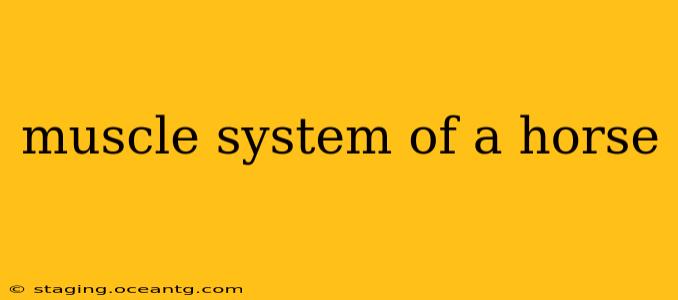Horses, with their elegance and athleticism, possess a remarkably complex and powerful muscle system. This system is crucial for their locomotion, allowing for incredible speed, agility, and endurance. Understanding the equine muscle system provides insight into their movements, training needs, and potential injuries. This comprehensive guide delves into the intricacies of a horse's muscular anatomy, addressing common questions and concerns.
What are the main muscle groups in a horse?
Horses, like humans, have numerous muscle groups working in concert. However, the proportions and development differ significantly due to their quadrupedal nature and specialized functions. Key muscle groups include:
-
Locomotor Muscles: These are the largest and most powerful muscles, responsible for movement. They are found in the limbs and include the gluteal muscles (powering the hindquarters), the quadriceps and hamstrings (in the hind and forelegs), and the pectoral muscles (chest). The development of these muscles is directly linked to the horse's breed, discipline, and training.
-
Trunk Muscles: These muscles stabilize the torso and support the internal organs. They are crucial for maintaining balance and posture. Key muscles here include the abdominal muscles and the longissimus dorsi (the muscle running along the spine).
-
Head and Neck Muscles: These muscles control head movement, chewing, and swallowing. The muscles in the neck are particularly important for a horse's balance and the ability to carry its head correctly.
-
Facial Muscles: Although less prominent compared to other groups, facial muscles control expressions and contribute to the overall appearance.
How does a horse's muscle system differ from a human's?
While both horses and humans utilize skeletal muscle, there are key differences:
-
Proportion and Distribution: Horses have a much higher proportion of muscle mass in their hindquarters compared to their forequarters, reflecting the power generated for propulsion. Humans have a more balanced muscle distribution.
-
Muscle Fiber Type: The distribution of muscle fiber types (Type I, slow-twitch for endurance; Type II, fast-twitch for power) varies between species and even within different muscles of a horse. Racehorses, for example, might have a higher proportion of Type II fibers in their locomotor muscles.
-
Attachment Points: The specific attachment points of muscles to bones differ, reflecting the different skeletal structure and movements.
-
Overall Mass: Horses, naturally, have a significantly larger overall muscle mass than humans.
What are some common muscle problems in horses?
Several factors can lead to muscle problems in horses, including overexertion, improper training, injury, and underlying health conditions. Some common issues include:
-
Strains and Sprains: Overstretching or tearing of muscle fibers, often resulting from intense exercise or sudden movements.
-
Myositis: Inflammation of muscle tissue, potentially caused by infection, trauma, or autoimmune disorders.
-
Rhabdomyolysis (also known as tying-up): A potentially life-threatening condition involving muscle breakdown, often associated with strenuous exercise.
-
Muscle Atrophy: Wasting away of muscle tissue due to disuse, injury, or disease.
How can I tell if my horse has a muscle problem?
Signs of muscle problems in horses can vary depending on the specific condition but may include:
-
Lameness: Difficulty or unwillingness to move.
-
Swelling or Heat: Inflammation in a specific muscle group.
-
Stiffness: Resistance to flexion or movement.
-
Pain on Palpation: Sensitivity to touch in the affected area.
-
Muscle Tremors: Involuntary shaking of the muscles.
-
Changes in Behavior: Lethargy, unwillingness to work, or increased irritability.
What kind of veterinary care is needed for muscle problems in horses?
Veterinary care for muscle problems in horses may involve:
-
Physical Examination: A thorough assessment of the horse's posture, movement, and affected areas.
-
Diagnostic Imaging: Ultrasound or MRI to identify the extent of the damage.
-
Blood Tests: To rule out underlying health conditions.
-
Treatment: This might include rest, anti-inflammatory medication, physical therapy, or surgery in severe cases. The specific treatment plan depends on the severity and cause of the muscle problem.
This in-depth look at the equine muscle system emphasizes the importance of understanding the intricate workings of this complex system. Early detection and appropriate management are critical for maintaining a horse's health, performance, and well-being. Remember to consult with a veterinarian for any concerns regarding your horse's health.
